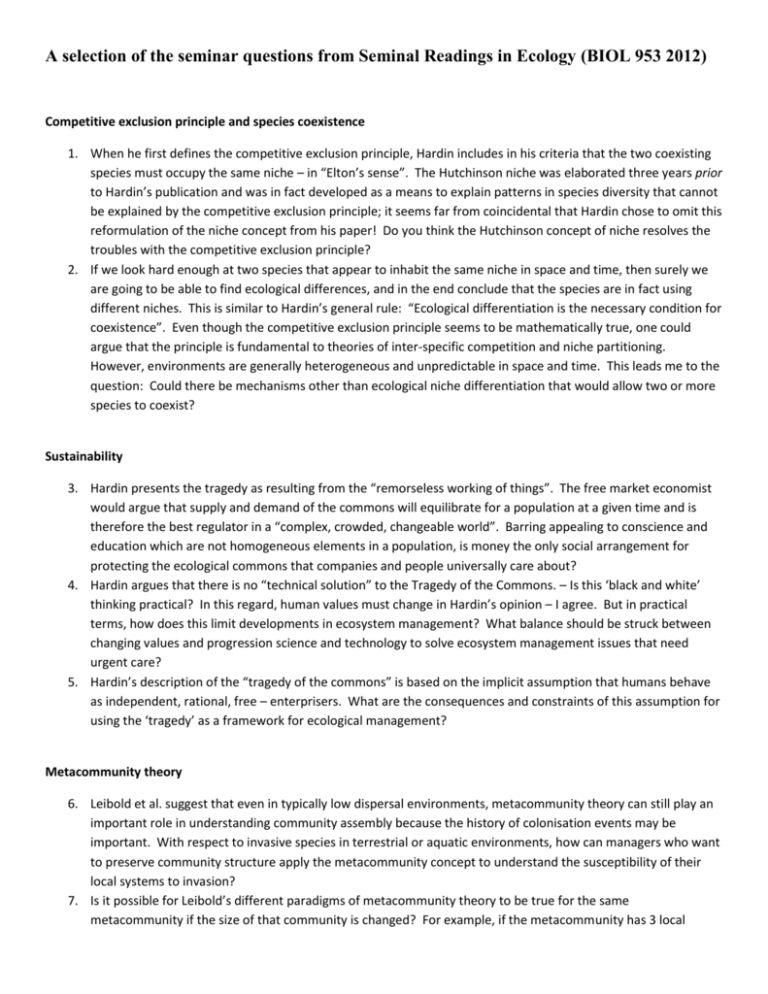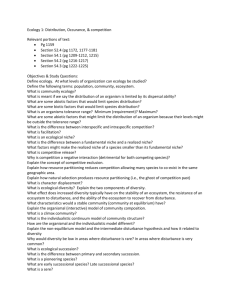Some of the best seminar questions
advertisement

A selection of the seminar questions from Seminal Readings in Ecology (BIOL 953 2012) Competitive exclusion principle and species coexistence 1. When he first defines the competitive exclusion principle, Hardin includes in his criteria that the two coexisting species must occupy the same niche – in “Elton’s sense”. The Hutchinson niche was elaborated three years prior to Hardin’s publication and was in fact developed as a means to explain patterns in species diversity that cannot be explained by the competitive exclusion principle; it seems far from coincidental that Hardin chose to omit this reformulation of the niche concept from his paper! Do you think the Hutchinson concept of niche resolves the troubles with the competitive exclusion principle? 2. If we look hard enough at two species that appear to inhabit the same niche in space and time, then surely we are going to be able to find ecological differences, and in the end conclude that the species are in fact using different niches. This is similar to Hardin’s general rule: “Ecological differentiation is the necessary condition for coexistence”. Even though the competitive exclusion principle seems to be mathematically true, one could argue that the principle is fundamental to theories of inter-specific competition and niche partitioning. However, environments are generally heterogeneous and unpredictable in space and time. This leads me to the question: Could there be mechanisms other than ecological niche differentiation that would allow two or more species to coexist? Sustainability 3. Hardin presents the tragedy as resulting from the “remorseless working of things”. The free market economist would argue that supply and demand of the commons will equilibrate for a population at a given time and is therefore the best regulator in a “complex, crowded, changeable world”. Barring appealing to conscience and education which are not homogeneous elements in a population, is money the only social arrangement for protecting the ecological commons that companies and people universally care about? 4. Hardin argues that there is no “technical solution” to the Tragedy of the Commons. – Is this ‘black and white’ thinking practical? In this regard, human values must change in Hardin’s opinion – I agree. But in practical terms, how does this limit developments in ecosystem management? What balance should be struck between changing values and progression science and technology to solve ecosystem management issues that need urgent care? 5. Hardin’s description of the “tragedy of the commons” is based on the implicit assumption that humans behave as independent, rational, free – enterprisers. What are the consequences and constraints of this assumption for using the ‘tragedy’ as a framework for ecological management? Metacommunity theory 6. Leibold et al. suggest that even in typically low dispersal environments, metacommunity theory can still play an important role in understanding community assembly because the history of colonisation events may be important. With respect to invasive species in terrestrial or aquatic environments, how can managers who want to preserve community structure apply the metacommunity concept to understand the susceptibility of their local systems to invasion? 7. Is it possible for Leibold’s different paradigms of metacommunity theory to be true for the same metacommunity if the size of that community is changed? For example, if the metacommunity has 3 local communities the mass effect paradigm may be the best explanation for patterns of community assembly, but if 6 local communities are studied the neutral paradigm may be best. 8. Under the mass-effect paradigm, immigration can supplement birth rates of a species “beyond what might be expected in a closed community”. If dispersal is unidirectional (it does not necessarily need to be) and incoming, then would an equilibrium (the seemingly implied prior state) be disrupted? Would the result of this immigration be emigration of new-arrived or of established individuals, or would there simply be an increase in mortality commensurate with decreased food availability per individual or increased predation risk? 9. The patch dynamic and neutral paradigms for metacommunities assume that “local sites do not differ in any respect except for the species composition that exists at any given moment”. This seems to be a major flaw in these models. After all, do not different species influence the local sites? For example, soil characteristics are modified by the species present (e.g. cedar tree litter acidifies the surrounding soil, while deciduous species may enhance soil fertility). Origins of cooperation within and among species 10. How does evolution of the guilt trait (i.e. experiencing bad conscience with regards to one’s moral values) correspond to the evolution of cooperation in humans? Would it be considered a positive or a negative influencing cooperation (in which one wants to benefit from the outcome)? 11. Is the evolution of cooperation in humans much different from the examples given regarding interspecies cooperation (e.g. plants and mycorrhizae, wasps and fig trees, ants and acacia trees)? Does our particularly well developed ability to communicate with each other interfere with our capacity for developing cooperation (intra and inter-species)? The problem of Scale 12. “Many ecologists…. focus on their small questions amenable to experimental tests and remain oblivious to the larger scale processes which may largely account for the patterns they study”. Levin is correct in my view to remind us that different processes are important at different scales. But it seems the quoted perspective missed out on a fundamental point. By turning the sentence around, ecologists are asking small scale questions because experimental evidence can be used to address them. It follows that if theory and methodology were developed, then ecologists would ask larger scale questions. In other words, “if you build it, they will come”? Has it been built? 13. An issue with the “transfer of information between different scales” is that the mechanisms working at a study site may not be the same mechanisms operation within the region as a whole. The difference may be due to ‘emergent properties’ as discussed by Levin. Is it possible to create a model that takes emergent properties into account so that it is possible to transfer information from small-scale experiment to large-scale models? For example, if a site displays properties A and B, can we know based on study of another system that property C will also be present at that site? Disturbance as a factor influencing community structure 14. In the literature it seems that as the idea of disturbance has been tested over the past 30 years, many especially recent studies have either rejected or at least questioned the role of intermediate levels of disturbance in maintaining diversity. If I am correct in this interpretation, why is it still such a broadly taught theory in undergraduate ecology courses? Do you think it is more or less important to the structuring of communities than other mechanisms such as niche partitioning, competitive exclusion etcetera? 15. Connell’s “gradual change” hypothesis to explain temporal patterns of community change in response to disturbance may be useful in considering the effects of climate change on species diversity. Based on the rate of climate change, could the concept be useful in predicting climate change effects on species with differing generation times? 16. Connell explicitly states that his hypotheses apply to plants and other sessile organisms that occupy most of the available space and largely determine the structure of the ecosystem. How might the intermediate disturbance hypothesis apply to animals with larger ranges and shorter life cycles? Does the nature of ‘equilibrium’ change for animal populations, and if so, how? Top predator effects on species diversity in communities 17. How does having a ‘top predator’ within an ecosystem affect its susceptibility to species invasion? Does having a top predator create a complex and stable food web that makes it difficult for a new species to become established or does the prevention of monopolisation of resources by top predators generate unoccupied niches that an invading species could take advantage of? 18. Paine’s pattern of increased stability of annual production leading to an increased capacity of ecosystems to support higher-level carnivores seems to suggest that more stable habitats allow for more predators, which in turn promotes diversity by preventing monopolisation. Are these more stable habitats closer to equilibrium, and if so shouldn’t competitive exclusion be operating? In other words, is Paine arguing against the competitive exclusion principle by concluding that the closer a system is to equilibrium, the more diversity it can sustain? 19. According to Paine’s 1966 paper, predation increases biodiversity by preventing competitive exclusion between prey species. However, predation in some instances can reduce biodiversity. Can this be reconciled with Paine’s hypothesis, or is some new or amended hypothesis necessary? Furthermore, the concept of disturbance and Connell’s intermediate disturbance hypothesis suggest that it would be possible to find high species diversity in regions without predators so long as other disturbances occur. If so, should Paine’s hypothesis be discarded in favour of a more generalised theory, such as the intermediate disturbance hypothesis (with predation considered as a (‘disturbance’)? 20. In the marine rocky tidal habitat where Paine’s studies were conducted, the limiting factor for organisms is space. In many other systems however, there are several limiting factors. Does the inclusion of multiple limiting factors constrain the application of Paine’s hypothesis to other ecosystems? 21. How does diversity among predator species affect the species diversity of lower trophic levels? Is the predator diversity a force driving niche specialisation at lower trophic levels, or does predator diversity itself arise from the extent of species diversity at lower trophic levels? Interpreting the evolutionary origins of organism traits 22. “The design is so elaborate, harmonious, and purposeful that we are tempted to view it as the starting point of any analysis, as the cause in some sense of the surrounding architecture. But this would invert the proper path of analysis. The system begins with an architectural constraint: the necessary four spandrels and their tapering triangular form.” While there are undoubtedly architectural constraints in creating a design, couldn’t the initial ‘vision’ for the building have selected for which architectural design (and therefore which constraints) to use? Perhaps then, this relationship is a cyclical one? 23. Gould and Lewontin describe bivalves that have shell patterns that are merely a by-product of another evolutionary selection process, and therefore are not a consequence of direct natural selection on that particular trait. As ecologists, we might consider morphology to be important in competition (e.g. maybe a certain shell pattern helps one bivalve species to outcompete others in some way) – but this might lead us to the ‘adaptionist programme’ when we try to explain why this trait came about. What steps can we as ecologists take to avoid this potential error, and what steps should we take to better understand a specie’s traits (especially life history features that are so important to understanding ecology)? 24. Phenotypic plasticity is rarely seen in a capacity that allows individuals to alter phenotype to perfectly match the environment, although one would think that this trait would be strongly selected for in heterogeneous environments in particular. Instead, intermediate levels of phenotypic plasticity are often observed, where phenotype is altered to match a particular environment but is insufficient to allow competitive exclusion of individuals of the same species that are native to that environment. There is little evidence for a ‘selection cost’ of plasticity, and so I think Gould and Lewontin may argue that the extent of plasticity may be restricted by ‘bauplan’ legacy constraints. What kinds of constraints are these likely to be?







